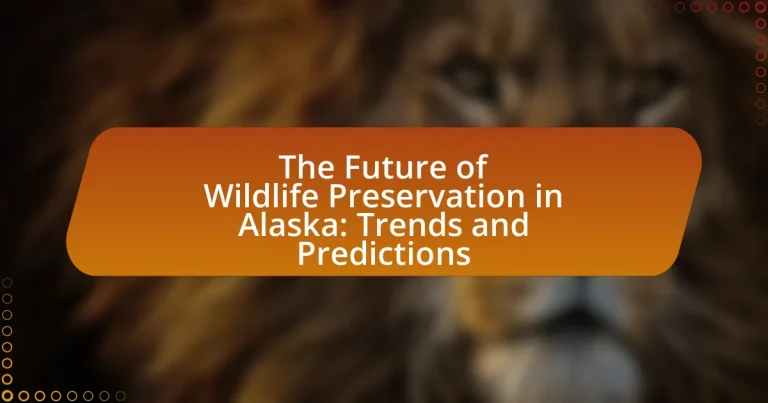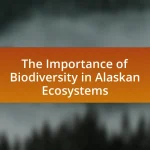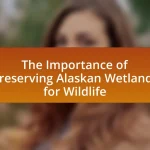The article focuses on the future of wildlife preservation in Alaska, addressing the current challenges such as climate change, habitat loss, and increased human activity that threaten biodiversity. It examines the impacts of these factors on specific species like polar bears, caribou, and salmon, and discusses the role of habitat fragmentation and human activities in wildlife management. Emerging trends in conservation strategies, including collaboration with indigenous communities and the use of technology for monitoring, are highlighted, along with predictions for future policies and practices aimed at enhancing wildlife preservation efforts in the region. The article emphasizes the importance of community engagement and education in supporting sustainable wildlife management.

What are the current challenges facing wildlife preservation in Alaska?
The current challenges facing wildlife preservation in Alaska include climate change, habitat loss, and increased human activity. Climate change is causing shifts in ecosystems, affecting species migration patterns and food availability. Habitat loss results from industrial development, such as oil extraction and mining, which disrupts natural habitats. Additionally, increased human activity, including tourism and urban expansion, leads to greater disturbances in wildlife areas. According to the U.S. Fish and Wildlife Service, these factors collectively threaten biodiversity and the health of ecosystems in Alaska, making effective wildlife management increasingly difficult.
How do climate change and habitat loss impact wildlife in Alaska?
Climate change and habitat loss significantly threaten wildlife in Alaska by altering ecosystems and reducing biodiversity. Rising temperatures lead to melting ice and permafrost, which disrupts the habitats of species such as polar bears and seals that rely on sea ice for hunting and breeding. Additionally, habitat loss from increased human activity and resource extraction further diminishes available space for wildlife, leading to population declines. For instance, studies indicate that the range of caribou herds is shifting due to changing vegetation patterns and climate conditions, impacting their migration and calving grounds. These changes not only affect individual species but also disrupt the intricate balance of the entire ecosystem, making wildlife in Alaska increasingly vulnerable.
What specific species are most affected by these changes?
The specific species most affected by changes in Alaska’s wildlife preservation are polar bears, caribou, and salmon. Polar bears are increasingly threatened by melting sea ice due to climate change, which disrupts their hunting patterns and habitat. Caribou populations are declining as their migratory routes are altered by changing vegetation and climate conditions. Salmon are impacted by rising water temperatures and altered river flows, which affect their spawning habitats. These species serve as indicators of broader ecological shifts, highlighting the urgent need for targeted conservation efforts in Alaska.
How does habitat fragmentation influence animal populations?
Habitat fragmentation negatively influences animal populations by isolating species, reducing genetic diversity, and limiting access to resources. When habitats are divided into smaller, disconnected patches, animals may struggle to find food, mates, and shelter, leading to population declines. Research indicates that fragmented landscapes can result in a 70% reduction in species richness, as seen in studies conducted in various ecosystems, including forests and grasslands. Additionally, fragmented habitats often lead to increased human-wildlife conflict and higher mortality rates due to roadways and urban development. These factors collectively threaten the survival of many species, making habitat connectivity crucial for wildlife preservation efforts.
What role do human activities play in wildlife preservation efforts?
Human activities play a crucial role in wildlife preservation efforts by enabling conservation initiatives, habitat restoration, and sustainable resource management. For instance, community engagement in Alaska has led to the establishment of protected areas, such as national parks and wildlife refuges, which safeguard critical habitats for species like the polar bear and caribou. Additionally, research and monitoring programs funded by human efforts provide essential data that inform conservation strategies, ensuring that wildlife populations are maintained and ecosystems are preserved. According to the U.S. Fish and Wildlife Service, collaborative efforts between local communities, government agencies, and non-profit organizations have resulted in significant improvements in the conservation status of various species in Alaska.
How does tourism affect wildlife habitats in Alaska?
Tourism negatively impacts wildlife habitats in Alaska by increasing human activity, which leads to habitat degradation and disturbance to animal behaviors. The influx of visitors can result in trampling of vegetation, pollution, and increased noise levels, all of which disrupt the natural environment. For instance, studies have shown that increased foot traffic in sensitive areas can lead to soil compaction and erosion, affecting plant growth and the overall ecosystem. Additionally, wildlife such as bears and moose may alter their natural behaviors, avoiding areas frequented by tourists, which can lead to decreased access to food and breeding grounds.
What are the implications of resource extraction on wildlife conservation?
Resource extraction significantly threatens wildlife conservation by disrupting habitats, leading to biodiversity loss. Activities such as mining, oil drilling, and logging can fragment ecosystems, making it difficult for species to thrive and reproduce. For instance, the U.S. Geological Survey reported that oil and gas development in Alaska has led to habitat degradation for species like caribou and polar bears, which rely on intact ecosystems for their survival. Additionally, resource extraction often introduces pollution and increases human-wildlife conflicts, further endangering vulnerable species. The cumulative effects of these activities can result in long-term ecological damage, undermining conservation efforts aimed at preserving wildlife in sensitive areas.
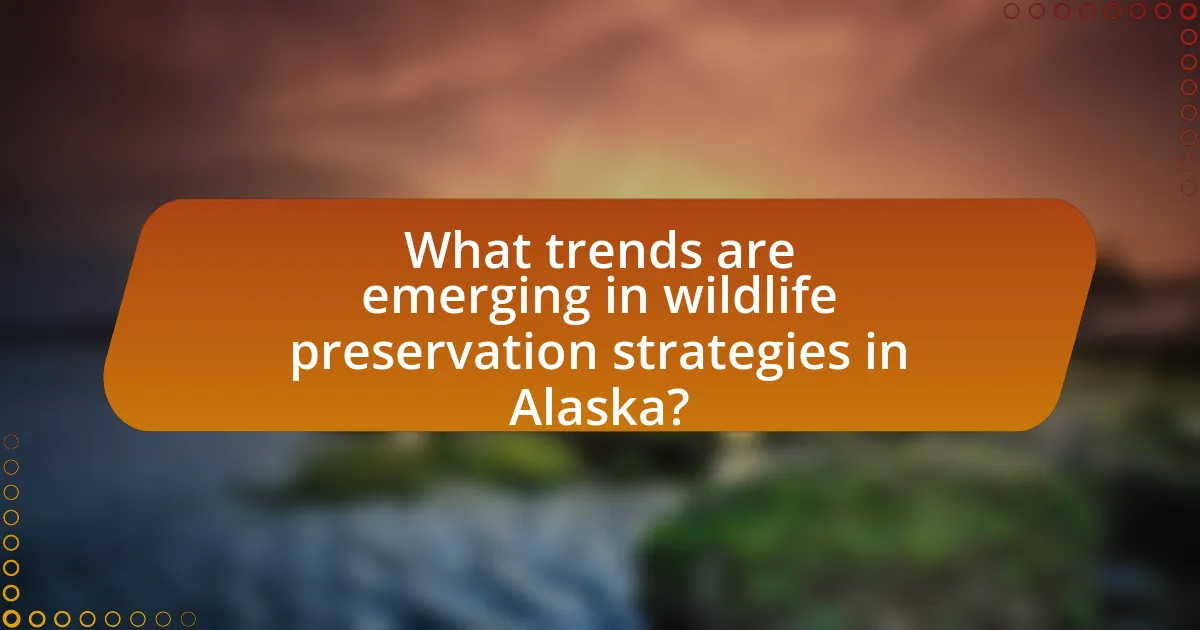
What trends are emerging in wildlife preservation strategies in Alaska?
Emerging trends in wildlife preservation strategies in Alaska include increased collaboration between indigenous communities and conservation organizations, the use of technology for monitoring wildlife populations, and a focus on climate resilience in habitat management. Indigenous communities are playing a crucial role in conservation efforts, leveraging traditional ecological knowledge to enhance biodiversity protection. Technological advancements, such as satellite tracking and remote sensing, are being utilized to gather data on wildlife movements and habitat changes, allowing for more informed decision-making. Additionally, strategies are increasingly incorporating climate change adaptation measures, recognizing the need to protect ecosystems that are vulnerable to shifting environmental conditions. These trends reflect a holistic approach to wildlife preservation that integrates cultural, technological, and ecological perspectives.
How are technology and innovation shaping conservation efforts?
Technology and innovation are significantly enhancing conservation efforts by enabling more effective monitoring, data collection, and habitat restoration. For instance, satellite imagery and drones allow conservationists to track wildlife populations and habitat changes in real-time, improving decision-making processes. Additionally, innovations such as genetic analysis and environmental DNA (eDNA) sampling provide precise information about species presence and biodiversity, which is crucial for targeted conservation strategies. According to a study published in the journal “Conservation Biology,” the use of eDNA has increased detection rates of rare species by up to 90%, demonstrating its effectiveness in conservation practices. These advancements not only streamline conservation efforts but also foster collaboration among researchers, policymakers, and local communities, ultimately leading to more sustainable wildlife preservation initiatives.
What tools are being used for wildlife monitoring and research?
Wildlife monitoring and research utilize tools such as GPS collars, camera traps, acoustic sensors, and satellite imagery. GPS collars enable researchers to track animal movements and behaviors in real-time, providing valuable data on migration patterns and habitat use. Camera traps capture images of wildlife, allowing for population estimates and behavioral studies without human interference. Acoustic sensors monitor animal vocalizations, which can indicate species presence and population dynamics. Satellite imagery offers insights into habitat changes and land use, aiding in conservation planning. These tools collectively enhance the understanding of wildlife populations and inform effective management strategies.
How can data analytics improve conservation strategies?
Data analytics can significantly improve conservation strategies by enabling data-driven decision-making and enhancing the understanding of wildlife populations and ecosystems. By analyzing large datasets, conservationists can identify trends, assess the health of species, and predict future changes in habitats. For instance, the use of satellite imagery and remote sensing data allows for real-time monitoring of land use changes and habitat degradation, which is crucial for timely interventions. Furthermore, predictive modeling can forecast the impacts of climate change on specific species, allowing for proactive measures to mitigate risks. Studies have shown that regions employing data analytics in their conservation efforts have seen improved outcomes, such as increased biodiversity and more effective resource allocation.
What collaborative efforts are being made between organizations and communities?
Collaborative efforts between organizations and communities in Alaska focus on wildlife preservation through partnerships that enhance conservation initiatives. For instance, the Alaska Wildlife Conservation Center collaborates with local tribes and environmental organizations to develop educational programs and habitat restoration projects. These partnerships leverage local knowledge and resources, fostering community engagement in wildlife management. Additionally, initiatives like the Alaska Migratory Bird Initiative involve multiple stakeholders, including government agencies and non-profits, to protect critical bird habitats, demonstrating a unified approach to conservation. Such collaborations are essential for effective wildlife preservation, as they combine scientific expertise with community involvement, leading to more sustainable outcomes.
How do local communities contribute to wildlife preservation initiatives?
Local communities contribute to wildlife preservation initiatives by actively participating in conservation efforts, implementing sustainable practices, and engaging in educational programs. These communities often collaborate with conservation organizations to create and enforce local regulations that protect wildlife habitats. For example, in Alaska, Indigenous communities have been instrumental in preserving traditional ecological knowledge, which informs sustainable hunting and fishing practices that benefit both wildlife and local ecosystems. Additionally, community-led initiatives, such as habitat restoration projects and wildlife monitoring programs, demonstrate the effectiveness of local involvement in enhancing biodiversity and ensuring the long-term viability of wildlife populations.
What partnerships are forming to enhance conservation outcomes?
Partnerships forming to enhance conservation outcomes in Alaska include collaborations between state agencies, non-profit organizations, and indigenous communities. For instance, the Alaska Department of Fish and Game has partnered with The Nature Conservancy to implement habitat restoration projects that benefit both wildlife and local ecosystems. Additionally, the collaboration between the U.S. Fish and Wildlife Service and various tribal organizations aims to integrate traditional ecological knowledge into conservation strategies, thereby improving the effectiveness of wildlife management. These partnerships are crucial as they leverage diverse expertise and resources, leading to more comprehensive and sustainable conservation efforts in the region.
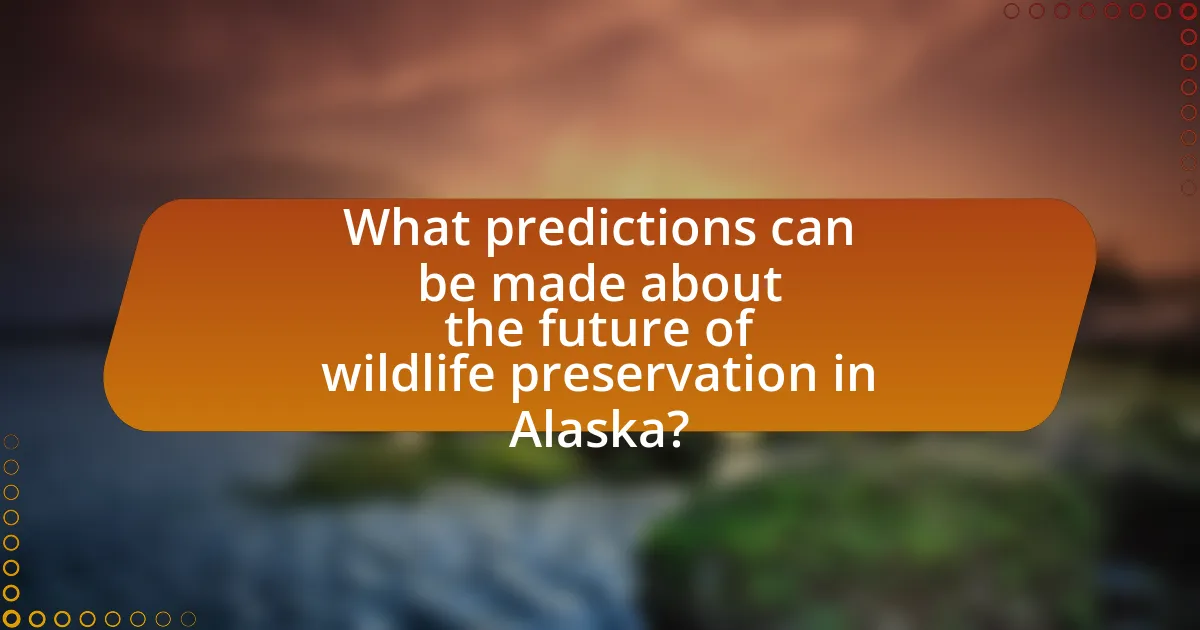
What predictions can be made about the future of wildlife preservation in Alaska?
Predictions about the future of wildlife preservation in Alaska indicate an increased focus on habitat protection and climate resilience strategies. As climate change continues to impact ecosystems, initiatives will likely prioritize the conservation of critical habitats for species such as polar bears and caribou, which are vulnerable to shifting environmental conditions. Furthermore, collaborative efforts among state agencies, indigenous communities, and conservation organizations are expected to enhance adaptive management practices, ensuring that wildlife populations can thrive despite changing climates. Studies, such as the Alaska Climate Change Strategy, emphasize the need for integrated approaches that consider both ecological and socio-economic factors, reinforcing the importance of sustainable practices in wildlife management.
How might climate change continue to influence wildlife populations?
Climate change will continue to influence wildlife populations by altering habitats, food availability, and migration patterns. As temperatures rise and precipitation patterns shift, ecosystems in Alaska are experiencing changes that affect species such as caribou, polar bears, and migratory birds. For instance, the melting of sea ice impacts polar bear hunting grounds, leading to decreased access to seals, their primary food source. Additionally, changing vegetation patterns can disrupt the food chain, affecting herbivores and, consequently, their predators. Studies indicate that these shifts can lead to population declines or changes in species distribution, as animals struggle to adapt to rapidly changing environments.
What adaptive strategies can be implemented to mitigate these effects?
Adaptive strategies to mitigate the effects of climate change on wildlife in Alaska include habitat restoration, species monitoring, and community engagement. Habitat restoration involves re-establishing native vegetation and improving ecosystem health, which supports biodiversity and resilience against climate impacts. Species monitoring utilizes data collection to track population changes and health, enabling timely interventions. Community engagement fosters local stewardship and awareness, ensuring that conservation efforts are supported by those most affected. These strategies are essential as they address the specific challenges posed by climate change, such as habitat loss and shifting species distributions, thereby enhancing the effectiveness of wildlife preservation efforts in Alaska.
How will changing ecosystems affect species diversity in Alaska?
Changing ecosystems will reduce species diversity in Alaska due to climate change and habitat alteration. As temperatures rise and precipitation patterns shift, many species face habitat loss, altered food availability, and increased competition from invasive species. For instance, studies indicate that warming temperatures are causing shifts in vegetation zones, which directly impacts the species that rely on specific habitats for survival. Additionally, the U.S. Geological Survey reports that species such as the polar bear and caribou are experiencing population declines linked to changing ecosystems, highlighting the direct correlation between ecosystem changes and species diversity loss in the region.
What policies are likely to shape the future of wildlife conservation?
Policies likely to shape the future of wildlife conservation include habitat protection regulations, climate change mitigation strategies, and sustainable resource management practices. Habitat protection regulations, such as the establishment of protected areas and wildlife corridors, are essential for preserving biodiversity and ensuring species survival. Climate change mitigation strategies, including emissions reduction and adaptation plans, are critical as climate change poses significant threats to wildlife habitats and ecosystems. Sustainable resource management practices, which involve balancing ecological health with economic development, are necessary to prevent overexploitation of wildlife and their habitats. These policies are supported by scientific research indicating that effective conservation requires a multifaceted approach that addresses both environmental and socio-economic factors.
How can legislation support sustainable wildlife management practices?
Legislation can support sustainable wildlife management practices by establishing regulatory frameworks that promote conservation, habitat protection, and responsible resource use. For instance, laws such as the Endangered Species Act in the United States provide legal protections for threatened species and their habitats, ensuring that development and land use do not compromise biodiversity. Additionally, legislation can enforce sustainable hunting and fishing quotas, which help maintain population levels and ecosystem balance. Research indicates that regions with strong wildlife protection laws experience higher biodiversity and healthier ecosystems, demonstrating the effectiveness of legal measures in promoting sustainable practices.
What role will public awareness and education play in future efforts?
Public awareness and education will be crucial in future efforts for wildlife preservation in Alaska by fostering community engagement and promoting sustainable practices. Increased public knowledge about local ecosystems and species can lead to greater advocacy for conservation initiatives, as evidenced by studies showing that informed communities are more likely to participate in preservation activities. For instance, a survey conducted by the Alaska Department of Fish and Game indicated that educational programs significantly increased public involvement in wildlife management decisions. Thus, enhancing awareness and education will empower individuals to take action, ultimately contributing to the effectiveness of wildlife preservation strategies in Alaska.
What practical steps can individuals take to support wildlife preservation in Alaska?
Individuals can support wildlife preservation in Alaska by participating in local conservation efforts, such as volunteering with organizations focused on habitat restoration and wildlife monitoring. Engaging in responsible outdoor activities, like adhering to guidelines for wildlife viewing and minimizing human impact on natural habitats, also contributes to preservation efforts. Additionally, individuals can advocate for policies that protect wildlife and their habitats by contacting local representatives and supporting legislation aimed at conservation. According to the Alaska Department of Fish and Game, community involvement is crucial for effective wildlife management and preservation, highlighting the importance of individual actions in sustaining Alaska’s diverse ecosystems.
How can local residents engage in conservation activities?
Local residents can engage in conservation activities by participating in community-led initiatives such as habitat restoration projects, wildlife monitoring programs, and educational workshops. These activities not only enhance local ecosystems but also foster a sense of stewardship among residents. For instance, the Alaska Wildlife Conservation Center offers volunteer opportunities for residents to assist in caring for injured wildlife and maintaining natural habitats, demonstrating the impact of local involvement on wildlife preservation efforts.
What resources are available for those interested in wildlife advocacy?
Numerous resources are available for individuals interested in wildlife advocacy, including organizations, educational programs, and online platforms. Notable organizations such as the World Wildlife Fund and the National Wildlife Federation provide extensive materials, advocacy training, and networking opportunities for wildlife advocates. Educational programs offered by universities and conservation groups often include workshops, webinars, and certification courses focused on wildlife conservation strategies. Additionally, online platforms like social media groups and forums facilitate community engagement and information sharing among wildlife advocates. These resources collectively support the efforts of individuals dedicated to wildlife preservation and advocacy.
